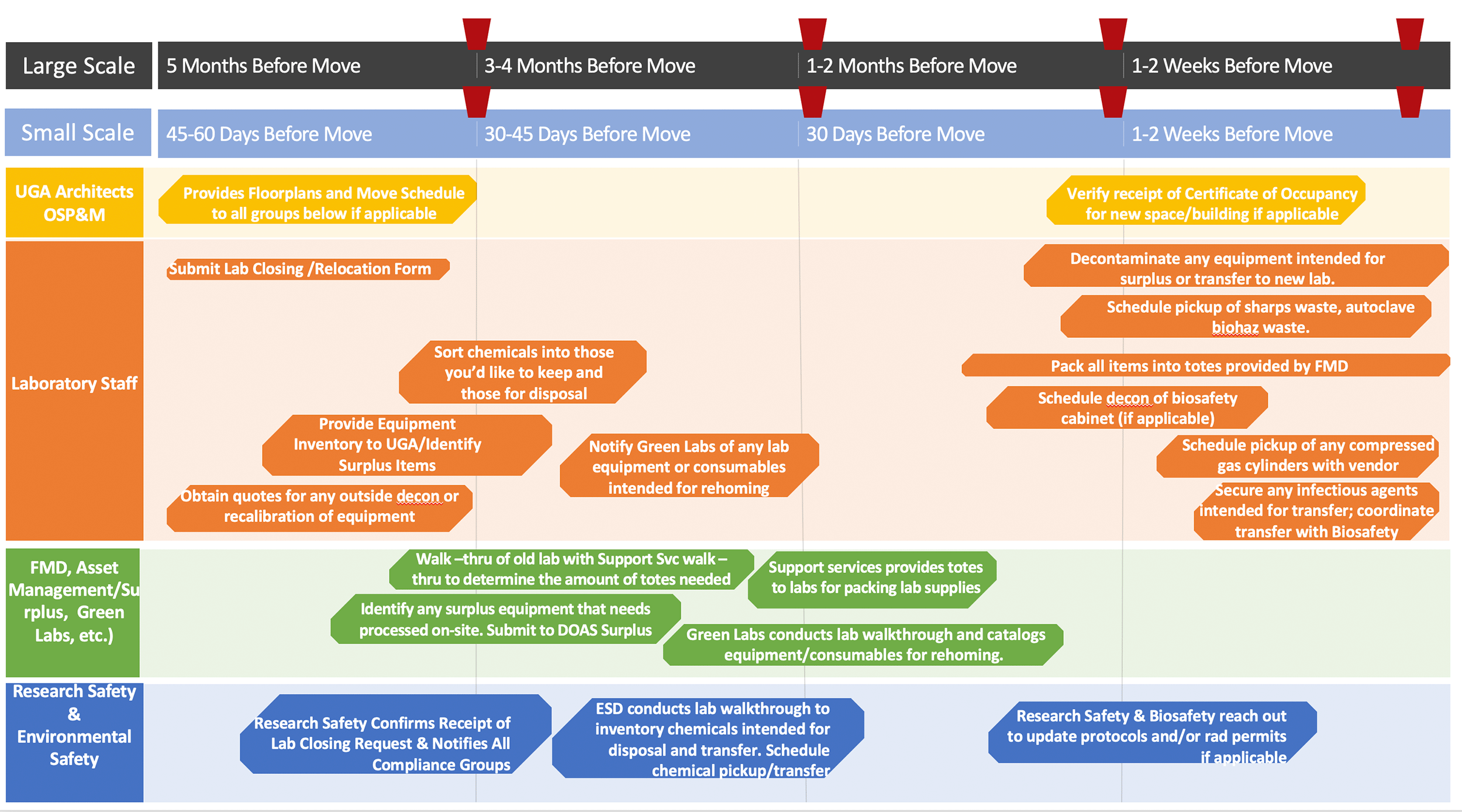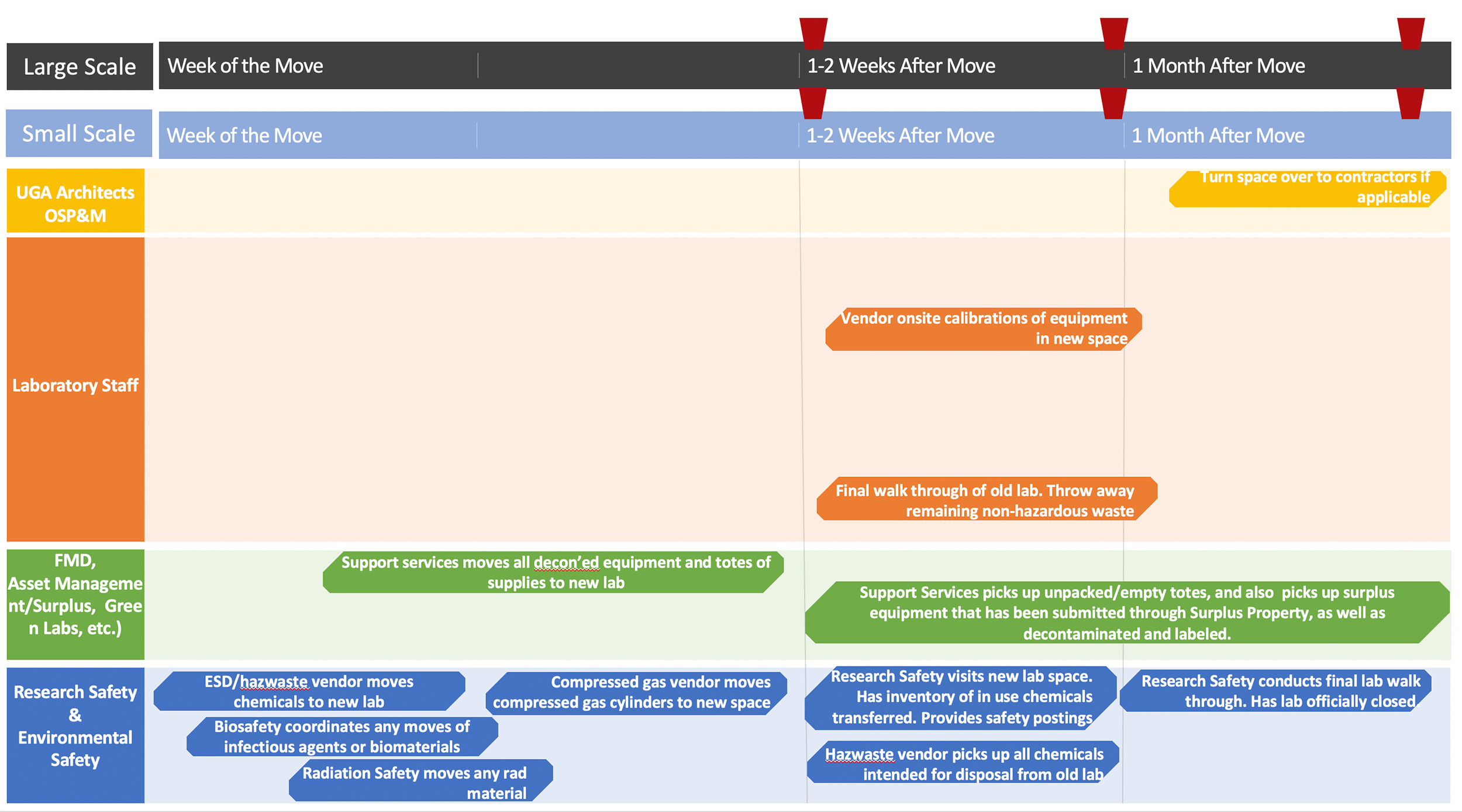Research Safety
Opening Labs, Closing Labs, & Relocating Labs
The instructions below define responsibilities when UGA labs are being opened, closed, or relocated. Also included in these instructions are guidelines and considerations for relocating laboratory equipment.
There are minimum safety and regulatory requirements that must be met before any lab is allowed to become operational. Similarly, when laboratories are vacated, they must be left in a condition that is safe and suitable for a new occupant or other employees involved in renovation projects.
UGA splits lab changes into two different types: small-scale and large scale. A small-scale change involves a single PI or research group. A large-scale change involves multiple PIs or research groups and/or entire departments or buildings and is almost always associated with a capital construction or renovation project.
Opening a New Laboratory
For new PIs or current PIs expanding their laboratory footprint within UGA:
- Submit a lab opening request by filling out the Open New Lab Request Form. A member of ORS will contact you to assist in getting your laboratory opened in a safe and compliant manner.
- Do not transfer chemical waste from one room to another. Have all chemical waste picked up through the hazardous materials program prior to vacating a lab.
- All new hazardous chemicals must be purchased through UGAmart.
- You and your staff should complete all appropriate EH&S training.
- If you are transferring chemicals from one space to another on campus, ensure that any changes are reflected in your inventory within Chematix.
- Familiarize yourself with UGA’s Chemical and Laboratory Safety Manual.
Decommissioning or Relocating a Laboratory
Additional details on these processes can be found in the Laboratory Decommissioning & Relocation Guidelines
Home Departments are responsible to:
- For a large-scale move or decommissioning, assign primary point of contact for the move and establish a departmental or building-level working group comprised of representatives from each unit involved in the move to support the primary point of contact. Responsibilities for this group would include coordination with external vendors such as for sharps collection or decontamination of biosafety cabinets. For small-scale moves, the PI will be assumed to be the primary point of contact.
- For all moves and decommissioning, ensure all PI & Laboratory Personnel tasks listed below are completed in a thorough and timely manner to minimize impact to research functions. In the event that a PI leaves without notice or experiences an unexpected emergency rendering them incapable of completing their responsibilities, then those responsibilities default to the Department Head or their designee.
PI & Laboratory Personnel are responsible to:
- For small-scale changes, inform the Office of Research Safety of the intention to move via the Lab Opening/Closing/Relocation Form. For large-scale moves, this notification will be managed by the Office of Space Planning & Management.
- Make arrangements for the transportation or final disposition of laboratory equipment.
- Appropriately decontaminate all laboratory equipment and surfaces.
- Dispose of all non-hazardous and hazardous waste and ensure that the laboratory space is clean.
- Update any research compliance protocols with relevant information.
- Ensure that all applicable permits are in place if needed.
- If a laboratory fails to complete all of the necessary tasks by assigned deadlines, oversight and support groups listed below would step in to ensure that the move or decommissioning happens on schedule. In these cases, the lab’s department will be charged for these services.
Equipment Moves Not Involving a Laboratory Change
For researchers simply needing to transfer equipment to another lab or have it removed to surplus:
- Please consult the Laboratory Equipment Decontamination Guidelines for important information on how to properly clean, decontaminate, and prepare laboratory equipment for relocation or removal.
- Please consult the Guidelines for Inter-Entity Transport of Freezers Containing Infectious Agents for information on how to prepare your non-empty freezers for relocation.
Timelines
The graphic below provides a general overview of the timeline and responsibilities of all stakeholders involved in a lab decommissioning or relocation. Upon notification either via the webform (for small-scale changes or from the Office of Space Planning and Management for large-scale changes), a project-specific timeline will be generated in SmartSheet that may look different than the generic diagram shown below. This diagram is only meant to provide you with a general timeline that will be applicable in most cases.
UGA Entity Roles and Contact Information
| DEPARTMENT | ROLE | PHONE | |
|---|---|---|---|
| Biosafety | Provide risk assessment for biosafety cabinets’ relocation; provides guidance for laboratory decontamination and disposal of biohazardous waste; provides training to personnel that transport biohazardous materials. | 706-542-7265 | biosfty@uga.edu |
| Radiation Safety | Dispose of radioactive waste upon request. | 706-542-0107 | radiation-safety@uga.edu |
| Research Safety | Receive Laboratory Closing/Relocation Forms for small scale changes and consult with PIs on chemical inventories / transfers. | 706-542-9088 | researchsafety@uga.edu |
| Environmental Safety | Dispose hazardous waste upon request. | 706-542-5801 | hazmat@uga.edu |
| FMD Support Services | Provide consultation for upcoming moves and transport laboratory equipment. | 706-542-6742 706-542-7582 706-542-5129 | kevindw@uga.edu Jcdemp@uga.edu randye1@uga.edu |
| Asset Management | Provide support and guidance on UGA and Georgia DOAS surplus property policy and procedures. | 706-542-4390 | surplus@uga.edu |
| Green Labs Program | Facilitate reuse, recycling, or donation of unwanted lab materials. | 706-542-7884 | greenlab@uga.edu |
| University Architects | OUA manages planning, design, construction, and renovation of capital facilities. | 706-542-3605 | facilitiesinquiries@uga.edu |
| Office of Space Planning & Management | OSPM is the point of contact between OUA and other departments to coordinate departmental moves and will coordinate with all listed departments of large-scale laboratory changes. | 706-583-3880 | facilitiesinquiries@uga.edu |
| Waste Reduction Services | Support removal of waste materials from campus and waste reduction initiatives. | 706-542-1301 | facilitiesinquiries@uga.edu |


